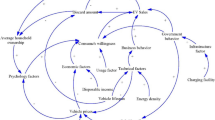Abstract
The ownership of electric vehicles, including plug-in electric vehicles (PEVs) and hybrid electric vehicles (HEVs), begins to be prevalent at present and poses as a promising way to alleviate environmental pollutions. However, the traditional method of environmental impact assessment is encountering challenges due to the large differences between conventional internal combustion engine vehicles (ICEVs) and electric vehicles. This paper proposes a novel SEA method for the penetration of electric vehicles at link level. An absorbing Markov chain model is formulated to represent the transition process among ICEVs, PEVs, and HEVs in the future, where PEV is an absorbing state. In addition, both HEV and PEV travelers are assumed to behave in the same manner as conventional ICEV travelers. As a result, the vehicle fleet composition is consistent with their market shares on each link. However, the three vehicle types are distinguished by their respective emissions rates. Therefore, the strategic environmental assessment can be worked out based on market penetration level and link traffic flows. For a given road network, transport system equilibrium is proposed to calculate link traffic flows. It is a four-step sequential model with feedback channel which can be solved by method of successive averages (MSA) effectively. For sustainable development, China plans to build a new city named Xiong’an nearby the capital Beijing. The strategic environmental assessment is conducted using the development of Xiong’an as an experimental study to demonstrate the effectiveness of proposed method. This research is very useful in urban planning with environmental constraints.






Similar content being viewed by others

References
Fischer, T. B. (2007). Theory and practice of strategic environmental assessment. London: Earthscan.
Mitropoulos, L. K., & Prevedouros, P. D. (2016). Incorporating sustainability assessment in transportation planning: an urban transportation vehicle-based approach. Transportation Planning and Technology, 39, 439–463.
Duell, M., Gardner, L., Waller, S.T. (2013) Multiobjective traffic network design accounting for plug-in electric vehicle energy consumption. Proceedings of the 92nd Annual Meeting of the Transportation Research Board, Washington, D.C.
Gardner, L. M., Duell, M., & Waller, S. T. (2013). A framework for evaluating the role of electric vehicles in transportation network infrastructure under travel demand variability. Transportation Research Part A: Policy and Practice, 49, 76–90.
Javid, R. J., & Nejat, A. (2017). A comprehensive model of regional electric vehicle adoption and penetration. Transport Policy, 54, 30–42.
Ma, J., Cheng, L., Li, D.W., Tu, Q. (2018) Stochastic electric vehicle network considering environmental costs. Sustainability 10.
Duell, M., Gardner, L. M., & Waller, S. T. (2018). Policy implications of incorporating distance constrained electric vehicles into the traffic network design problem. Transportation Letters-the International Journal of Transportation Research, 10, 144–158.
He, F., Yin, Y., & Lawphongpanich, S. (2014). Network equilibrium models with battery electric vehicles. Transportation Research Part B: Methodological, 67, 306–319.
Jiang, N., & Xie, C. (2014). Computing and analyzing mixed equilibrium network flows with gasoline and electric vehicles. Computer-Aided Civil and Infrastructure Engineering, 29, 626–641.
Pasaoglu, G., Harrison, G., Jones, L., Hill, A., Beaudet, A., & Thiel, C. (2016). A system dynamics based market agent model simulating future powertrain technology transition: scenarios in the EU light duty vehicle road transport sector. Technological Forecasting and Social Change, 104, 133–146.
Struben, J., & Sterman, J. D. (2008). Transition challenges for alternative fuel vehicle and transportation systems. Environment and Planning. B, Planning & Design, 35, 1070–1097.
Oppenheim, N. (1995) Urban travel demand modeling: from individual choices to general equilibrium. John Wiley and Sons.
Sheffi, Y. (1985). Urban transportation networks: Equilibrium analysis with mathematical programming methods. Englewood Cliffs, NJ: Prentice-Hall.
Boyce, D. (2002). Is the sequential travel forecasting paradigm counterproductive? Journal of Urban Planning and Development, 128, 169–183.
Boyce, D., & Xiong, C. (2007). Forecasting travel for very large cities: challenges and opportunities for China. Transportmetrica, 3, 1–19.
Boyce, D., & Zhang, Y.-F. (1997). Calibrating combined model of trip distribution, modal split, and traffic assignment. Transportation Research Record, 1607, 1–5.
Boyce, D. E., Zhang, Y.-F., & Lupa, M. R. (1994). Introducing “feedback” into four-step travel forecasting procedure versus equilibrium solution of combined model. Transportation Research Record, 1443, 65–74.
Boyce, D., O’Neill, C.R., Scherr, W. (2007) New computational results on solving the sequential procedure with feedback. Proceedings of 11th TRB National Planning Applications Conference, Daytona Beach, Fla.
Boyce, D., O’Neill, C., & Scherr, W. (2008). Solving the sequential travel forecasting procedure with feedback. Transportation Research Record, 2077, 129–135.
Feng, X., Zhang, J., Fujiwara, A., & Senbil, M. (2007). Evaluating environmentally sustainable urban and transport policies for a developing city based on a travel demand model with feedback mechanisms. Journal of the Eastern Asia Society for Transportation Studies, 7, 751–765.
Loudon, W., Parameswaran, J., & Gardner, B. (1997). Incorporating feedback in travel forecasting. Transportation Research Record, 1607, 185–195.
Qin, C. (2014). Comparison of alternate feedback methods for the four-step model. Irvine: University of California.
Acknowledgments
The authors would like to thank the anonymous reviewers for their constructive suggestions that improved the paper significantly.
Funding
This work is funded by the National Natural Science Foundation of China (No. 11771078) and the Fundamental Research Funds for the Central Universities (No. 2242019S20012).
Author information
Authors and Affiliations
Corresponding author
Additional information
Publisher’s Note
Springer Nature remains neutral with regard to jurisdictional claims in published maps and institutional affiliations.
Rights and permissions
About this article
Cite this article
Lin, H., Zhang, Y. Strategic Environmental Assessment with the Penetration of Electric Vehicles in Transport Network. Environ Model Assess 25, 493–503 (2020). https://doi.org/10.1007/s10666-020-09691-0
Received:
Accepted:
Published:
Issue Date:
DOI: https://doi.org/10.1007/s10666-020-09691-0



